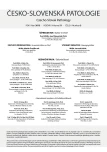Antibody-mediated rejection of renal allograft and the update Banff classification 2013
Authors:
Eva Honsová
Authors‘ workplace:
Pracoviště klinické a transplantační patologie, Transplantcentrum IKEM
Published in:
Čes.-slov. Patol., 51, 2015, No. 3, p. 116-119
Category:
Reviews Article
Overview
The view on the role of donor-specific antibodies in organ transplantation has been changed during the last several decades. Today, it is considered that the majority of cases of the late renal allograft dysfunction and loss are caused by the presence of donor-specific antibodies to HLA antigens. The real breakthrough in the diagnosis of antibody-mediated rejection was represented by the discovery of C4d, which enabled the determination of the diagnostic criteria of acute and later chronic antibody-mediated rejection. Although detection of C4d has been the cornerstone in the diagnosis of antibody-mediated rejection for over 10 years, it has become clear that some cases with similar morphological and clinical features do not have detectable C4d.
Outcomes of key studies concerning presence of donor specific antibodies and morphological features in the graft biopsy samples resulted in the modification of Banff classification of 2013, which includes integrating C4d negative antibody-mediated rejection and also that acute vascular rejection (v1, v2) can be a part of the antibody-mediated rejection.
Keywords:
kidney allograft – antibody-mediated rejection – T-cell mediated rejection
Sources
1. Solez K, Colvin RB, Racusen LC, Haas M, et al. Banff 07 classification of renal allograft pathology: updates and future directions. Am J Transplant 2008; 8: 753-760.
2. Feucht HE, Schneeberger H, Hillebrand G, et al. Capillary deposition of C4d comlement fragment and early renal graft loss. Kidney Int 1993; 43: 1333-1338.
3. Nadazdin O, Boskovic S, Colvin RB, et al. Contributions of direct and indirect alloresponses to chronic rejection of kidney allografts in nonhuman primates. J Immunol 2011; 187: 4589-4597.
4. Sis B, Halloran PF. Endothelial transcripts uncover a previously unknown phenotype: C4d-negative antibody-mediated rejection. Curr Opin Organ Transplant 2010; 15: 42-48.
5. Russell PS, Chase CM, Winn HJ, et al. Coronary atherosclerosis in transplanted mouse hearts. II. Importance of humoral immunity. J Immunol 1994, 152: 1535-1541.
6. Hirohashi T, Uehara S, Colvin RB, et al. Complement independent antibody-mediated endarteritis and transplant arteriopathy in mice. Am J Transplant 2010; 10(3): 510-517.
7. Lefaucheur C, Loupy A, Vernerey D, et al. Antibody-mediated vascular rejection of kidney allografts: a population-based study. Lancet 2013; 381: 313-319.
8. Haas M, Sis B, Racusen LC, et al. Banff 2013 meeting report: inclusion of C4d-negative antibody-mediated rejection and antibody-associated arterial lesions. Am J Transplant 2014; 14: 272-283.
Labels
Anatomical pathology Forensic medical examiner ToxicologyArticle was published in
Czecho-Slovak Pathology

2015 Issue 3
Most read in this issue
- Pyloric gland adenoma: a histologic, immunohistochemical and molecular genetic study of 23 cases
- Infections after kidney transplantation
- Neuroendocrine tumor of the breast - metastasis or primary breast carcinoma? Case report
- Antibody-mediated rejection of renal allograft and the update Banff classification 2013
